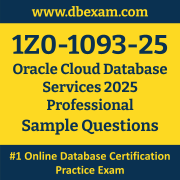01. Which three statements are true about Exadata Snapshots on the Exadata Database Service?
a) Before creating Exadata Snapshots from the test master, you can modify the data in the test master, if required.
b) Exadata Snapshots are unable to utilize all the Exadata features.
c) Exadata Snapshots utilize the Exadata SPARSE disk group to store the sparse files that contain all the data that is read and written by the Snapshots.
d) Exadata Snapshots utilize the Exadata SPARSE disk group to store the sparse files that contain only changed blocks.
e) Multiple users can create independent Exadata Snapshots from the same test master, which is a full read-only clone of the source database.
02. Exadata Database Service is started with BYOL as the license type. How can you change your license type?
a) Use the Move database option to relocate to a new Database Home on the VM Cluster with the desired license type.
b) Update the license type by submitting a service request (SR) to support.
c) Use the Update License Type option on the VM Cluster details page to switch license type online.
d) Use the Update License Type option on the VM Cluster details page to restart the VM Cluster with the desired license type.
03. Which two tools can you use to create a HeatWave MySQL Database Service System?
a) OCI SQL Developer
b) MySQL Shell on OCI Compute
c) OCI Bastion Server
d) OCI Console
e) OCI Command Line Interface
04. What is the primary function of the MySQL Shell Upgrade Checker Utility when upgrading from MySQL 5.7 to MySQL 8?
a) It checks the MySQL 5.7 instance for compatibility errors and issues.
b) It converts the data from the old 5.7 storage engine to the new 8.0 storage engine.
c) It generates the script command for migrating the instance to MySQL 8.
d) It assists database administrators by upgrading the database automatically.
e) It automatically fixes compatibility errors and issues.
05. For which two reasons do you need a minimum of three storage cells when using Exadata Database Service?
a) Real Application Clusters
b) Fast Start Failover of storage cells
c) High availability
d) Data Guard
e) Triple mirroring of data
06. In which version of Oracle Database can you fast provision a virtual machine (VM) database (DB) system, using Logical Volume Manager (LVM) for storage management?
a) Oracle Databases that could use Automatic Storage Management (ASM)
b) Oracle Database versions 12.2 and greater
c) Oracle Database versions 18c and greater
d) Any currently supported release of the Oracle Database
07. You want to scale within the Exadata System. Which two statements are true?
a) If you have set the database parameter CPU_COUNT for instance caging, it is not affected by any modification to the number of enabled OCPUs.
b) If you have set the database parameter CPU_COUNT for instance caging, it is affected by any modification to the number of enabled OCPUs.
c) Modifying the number of enabled OCPUs does not require database downtime.
d) Modifying the number of enabled OCPUs requires database downtime.
08. If you notice throttling on your NoSQL Database Cloud Service, what must you increase to solve it?
a) Index size
b) Data size
c) OCPU for all servers in the cluster
d) Storage capacity
09. Which two are the same for a base system and a quarter rack?
a) Maximum number of enabled OCPUs
b) Number of compute servers
c) Number of Exadata storage servers
d) Total raw storage capacity
e) Total raw flash storage capacity
10. You are designing an Exadata Database Service–based architecture for a customer who has a requirement that all maintenance, including database upgrades, be completed with as little downtime as possible.
Which technology should be used?
a) Application Continuity
b) ASM instead of LVM
c) Multitenant
d) RMAN
e) Active Data Guard
 The Oracle Cloud Database Services Professional (1Z0-1093-25) Sample Question Set is designed to help you prepare for the Oracle Cloud Database Services 2025 Certified Professional certification exam. To become familiar with the actual Oracle Certification exam environment, we suggest you try our Sample Oracle 1Z0-1093-25 Certification Practice Exam.
The Oracle Cloud Database Services Professional (1Z0-1093-25) Sample Question Set is designed to help you prepare for the Oracle Cloud Database Services 2025 Certified Professional certification exam. To become familiar with the actual Oracle Certification exam environment, we suggest you try our Sample Oracle 1Z0-1093-25 Certification Practice Exam.